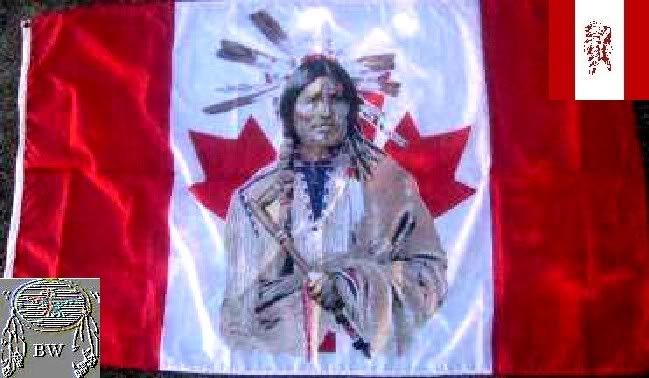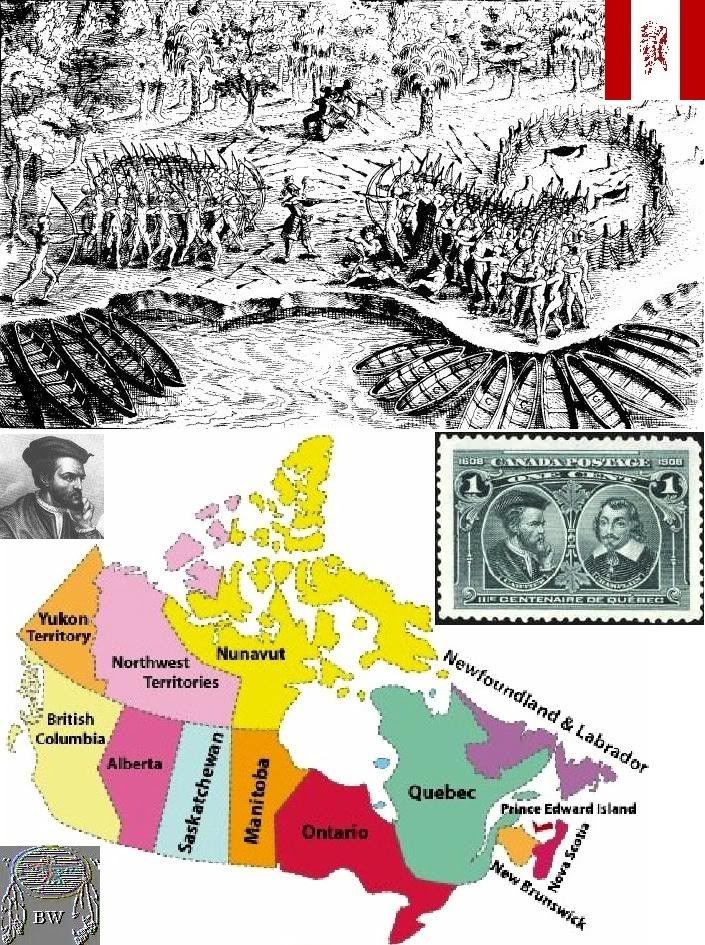|
BRAVEHORSE WARRIOR Pieskaret
Algonkin Warrior

 Chief Pieskaret
Warrior Citation
PIESKARET (Piescaret, Piescars, Diescaret), Simon, Algonkin chief of the tribe Tessouat or “Le Borgne”; d. 1647.
Pieskaret, according to Nicolas Perrot, was known as “the terror of the Iroquois” for they knew his valour well.
Many extraordinary deeds had rendered him “redoubtable” to the enemy. The Algonkins spoke of him as “a very
brave man,” and the Jesuits wrote that he was “a man somewhat noted among his people.” Pieskaret was mourned
as dead in 1643, believed to have been captured by Iroquois, but in early April he appeared with his band, opposite Montreal,
bearing the head of an enemy, having escaped the pursuing Iroquois because of the swift break-up of the river. This return
was celebrated with dancing, and a council was held after which Pieskaret and Tessouat (d. 1654) reported to Chomedey de Maisonneuve
their intention to go to Trois-Rivières to formulate plans for the future and to determine if the French were to keep their
promise of assistance against the enemy.
Chief Pieskaret
Warrior Citation
PIESKARET (Piescaret, Piescars, Diescaret), Simon, Algonkin chief of the tribe Tessouat or “Le Borgne”; d. 1647.
Pieskaret, according to Nicolas Perrot, was known as “the terror of the Iroquois” for they knew his valour well.
Many extraordinary deeds had rendered him “redoubtable” to the enemy. The Algonkins spoke of him as “a very
brave man,” and the Jesuits wrote that he was “a man somewhat noted among his people.” Pieskaret was mourned
as dead in 1643, believed to have been captured by Iroquois, but in early April he appeared with his band, opposite Montreal,
bearing the head of an enemy, having escaped the pursuing Iroquois because of the swift break-up of the river. This return
was celebrated with dancing, and a council was held after which Pieskaret and Tessouat (d. 1654) reported to Chomedey de Maisonneuve
their intention to go to Trois-Rivières to formulate plans for the future and to determine if the French were to keep their
promise of assistance against the enemy.
 In the early spring of 1645, while it was still necessary to drag their canoes on ice on the St. Lawrence, Pieskaret
led a war-party to the Richelieu River and Lake Champlain, where they made successful raids on a band of Iroquois, killing
several and taking two as captives. On their return to the mission at Sillery, the captives could be seen dancing in the canoes
according to custom, and enemy scalps were floating from long sticks “like vanes” in the wind. The captive Iroquois
(one of whom was Honatteniate) were treated kindly by the residents of Sillery in deference to the French. Pieskaret handed
over the captives to the governor, Huault de Montmagny, who shortly after sent word to the Iroquois by another Iroquois captured
at an earlier date, that the captives would be freed if the Iroquois were disposed to treat for peace. This resulted in the
arrival of Kiotseaeton, as ambassador from the Iroquois, in July. A peace council was then held with the Iroquois, the French,
and the Hurons, Algonkins, and Montagnais, at the end of which Pieskaret presented furs to the Iroquois ambassador, symbolizing
“a rock or tomb” placed on the grave of the victims of the above-mentioned battle, so that all might be forgiven
and no revenge sought. The ensuing short-lived, but important, peace and trade negotiations of 1645–46 openly allotted
to the Mohawks a share of the northern fur trade (a clause which was never implemented), while secretly excluding the pagan
Algonkins from French protection. By 1646–47 many tribes had taken up residence in the Trois-Rivières area because of
the growing intensity of the Iroquois menace. Confusion and controversies developed. To solve the difficulties the Indians
appointed Pieskaret to maintain the peace between the French and the Indians, and between the Hurons and the Algonkins, with
power to punish delinquents, especially if the fault were a religious one. He is said to have discharged his duty faithfully.
Pieskaret had been baptized at Trois-Rivières in 1640 or 1641, and given the name of Simon by M. de Champflour, the governor.
However, in 1646–47, being affected by the sudden death of Joseph Oumasasikweie, a Christian convert and a nephew of
Tessouat (d. 1654), he made public confession and renewed his faith, which he had accepted formerly for diplomatic reasons
only. Indirectly, Pieskaret’s open avowal of Christianity may have been the cause of his death. When returning from
hunting on the north shore of the St. Lawrence in March 1647, laden with muzzles and tongues of elks, Pieskaret met a band
of Iroquois (now allowed to hunt in this area by the terms of the 1645 treaty), who were singing the peace-song. Although
rumours of the secret clause in the treaty had already reached Pieskaret and there was general fear of an Iroquois attack,
he, doubtless counting on his Christian faith to protect him, smoked the pipe with the Iroquois and they addressed each other
with words of respect. But when the journey was resumed, Pieskaret, who walked in the centre, was treacherously killed and
scalped by one of the Iroquois who lagged behind. Numerous anecdotes attest to the prowess of Pieskaret. Perrot, for example,
recounts that on one occasion Pieskaret entered an Iroquois village, killed a whole family, and hid in one of their woodpiles
on two succeeding nights. On the third he was detected. He fled, but being “naturally agile and nimble,” he out-distanced
his pursuers and took refuge in a tree trunk. Later, when the Iroquois set up camp near by, Pieskaret killed them all in their
sleep and “came back laden with their scalps.” Another time, at the mouth of the Sorel [probably Richelieu] River,
he, with four others, sank five Iroquois canoes by firing on them, then killed all of the enemy but saved the captives who
were travelling with them. From: historical accounts & records
In the early spring of 1645, while it was still necessary to drag their canoes on ice on the St. Lawrence, Pieskaret
led a war-party to the Richelieu River and Lake Champlain, where they made successful raids on a band of Iroquois, killing
several and taking two as captives. On their return to the mission at Sillery, the captives could be seen dancing in the canoes
according to custom, and enemy scalps were floating from long sticks “like vanes” in the wind. The captive Iroquois
(one of whom was Honatteniate) were treated kindly by the residents of Sillery in deference to the French. Pieskaret handed
over the captives to the governor, Huault de Montmagny, who shortly after sent word to the Iroquois by another Iroquois captured
at an earlier date, that the captives would be freed if the Iroquois were disposed to treat for peace. This resulted in the
arrival of Kiotseaeton, as ambassador from the Iroquois, in July. A peace council was then held with the Iroquois, the French,
and the Hurons, Algonkins, and Montagnais, at the end of which Pieskaret presented furs to the Iroquois ambassador, symbolizing
“a rock or tomb” placed on the grave of the victims of the above-mentioned battle, so that all might be forgiven
and no revenge sought. The ensuing short-lived, but important, peace and trade negotiations of 1645–46 openly allotted
to the Mohawks a share of the northern fur trade (a clause which was never implemented), while secretly excluding the pagan
Algonkins from French protection. By 1646–47 many tribes had taken up residence in the Trois-Rivières area because of
the growing intensity of the Iroquois menace. Confusion and controversies developed. To solve the difficulties the Indians
appointed Pieskaret to maintain the peace between the French and the Indians, and between the Hurons and the Algonkins, with
power to punish delinquents, especially if the fault were a religious one. He is said to have discharged his duty faithfully.
Pieskaret had been baptized at Trois-Rivières in 1640 or 1641, and given the name of Simon by M. de Champflour, the governor.
However, in 1646–47, being affected by the sudden death of Joseph Oumasasikweie, a Christian convert and a nephew of
Tessouat (d. 1654), he made public confession and renewed his faith, which he had accepted formerly for diplomatic reasons
only. Indirectly, Pieskaret’s open avowal of Christianity may have been the cause of his death. When returning from
hunting on the north shore of the St. Lawrence in March 1647, laden with muzzles and tongues of elks, Pieskaret met a band
of Iroquois (now allowed to hunt in this area by the terms of the 1645 treaty), who were singing the peace-song. Although
rumours of the secret clause in the treaty had already reached Pieskaret and there was general fear of an Iroquois attack,
he, doubtless counting on his Christian faith to protect him, smoked the pipe with the Iroquois and they addressed each other
with words of respect. But when the journey was resumed, Pieskaret, who walked in the centre, was treacherously killed and
scalped by one of the Iroquois who lagged behind. Numerous anecdotes attest to the prowess of Pieskaret. Perrot, for example,
recounts that on one occasion Pieskaret entered an Iroquois village, killed a whole family, and hid in one of their woodpiles
on two succeeding nights. On the third he was detected. He fled, but being “naturally agile and nimble,” he out-distanced
his pursuers and took refuge in a tree trunk. Later, when the Iroquois set up camp near by, Pieskaret killed them all in their
sleep and “came back laden with their scalps.” Another time, at the mouth of the Sorel [probably Richelieu] River,
he, with four others, sank five Iroquois canoes by firing on them, then killed all of the enemy but saved the captives who
were travelling with them. From: historical accounts & records
|

